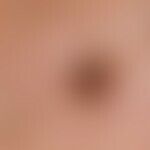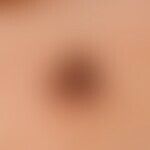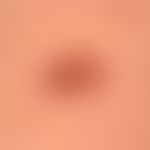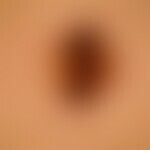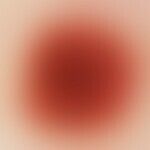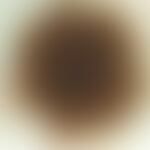Synonym(s)
DefinitionThis section has been translated automatically.
Benign, congenital or acquired, melanocyte-derived, brown to brown-black, less commonly reddish or skin-colored, patchy, nodular, plaque-like, or nodular melanocytic nevi that are usually plural but may also be solitary.
Melanocytic nevi may be confined to the epidermis(lentigo simplex, junctional melanocytic nevus), localized in the epidermis and dermis (compound type of melanocytic nevus), or localized exclusively in the dermis (dermal melanocytic nevus). This clinical/histologic typing denotes a sequential developmental process that all melanocytic nevi undergo in stages.
ClassificationThis section has been translated automatically.
Classification of congenital and acquired melanocytic nevi according to histological and clinical criteria:
-
Acquired melanocytic nevus:
- lentigo simplex
- Lentigo solaris (senilis)
- Lentigo, reticular
- Lentigo of the mucosa (melanosis of the mucosa)
- Nevus melanocytic acral
- Nevus melanocytic dysplastic (atypical)
-
Ordinary melanocytic nevus
- Usual melanocytic nevus junctional type
- Common melanocytic nevus compound type
- Common melanocytic nevus dermal type
- Nevus melanocytic halo-nevus
- recurrent melanocytic nevus
- Nevus Spitz
- Naevus melanocytic deep infiltrating
- Nevus melanocytic spindle cell nevus pigmented
- Bladder cell nevus (balloon cell nevus)
- Meyerson's melanocytic nevus.
-
congenital melanocytic nevus:
- Small congenital melanocytic nevus (< 4 cm)
- Large congenital melanocytic nevus (> 4 cm)
- Giant congenital melanocytic nevus (e.g. swimming trunks type)
- melanosis neurocutanea
- nevus spilus
-
Dermal melanocytosis:
- Mongolian spot
- Nevus fuscocoeruleus ophthalmomaxillaris (Naevus Ota)
- Naevus fuscocoeruleus deltoideoacromialis (Naevus Ito)
- Blue Nevus
You might also be interested in
EtiopathogenesisThis section has been translated automatically.
It has been postulated that melanocytic nevi originate from cells migrating from the neural crest into the epidermis. It is likely that melanocytes and "nevus cells" represent identical cell populations, so that the term "nevus cell" can be dispensed with in connection with melanocytic nevi (aka nevus cell nevus).
LocalizationThis section has been translated automatically.
On the whole integument, also on superficial mucous membranes possible.
HistologyThis section has been translated automatically.
Histologically, 3 variants can be distinguished:
- Junction type (epidermal initial stage)
- Compound type (epidermo-dermal)
- Dermal type: dermal melanocytic nevus.
Melanocytic nevi show intraepidermal and/or dermal accumulations of melanocytes. Melanocytes within the junctional zone have a round, oval, or spindle-shaped appearance and are located in contiguous nests. In the superficial dermis, the cells generally have an epithelioid cellular character with medium-sized, usually centrally located nuclei, and a distinct cytoplasmic rim. The degree of pigmentation is variable, either finely granular but also scollic across the cytoplasm. The nuclei show a uniform chromatin distribution with a slightly clumped texture. Deeper in the dermis, melanocytes lie in strands. Often, the cells show decreased cytoplasmic content. They then resemble lymphocytes and are often arranged in linear strands but also diffusely. The skin appendages are sheathed by the dermal melanocytes, but always remain intact.
LiteratureThis section has been translated automatically.
Ferrara G et al (2017) Wiesner nevus. CMAJ 189:E26.
- Garbe C (1992) Sun and malignant melanoma. Dermatologist 43: 251-257
- Hesse G et al. (1994) Microfilm documentation in the follow-up of melanocytic tumors. Dermatology 45: 532-535
- Maitra A et al. (2002) Loss of heterozygosity analysis of cutaneous melanoma and benign melanocytic nevi: laser capture microdissection demonstrates clonal genetic changes in acquired nevocellular nevi. Hum Pathol 33: 191-197
- Ruiter DJ et al. (2003) Current diagnostic problems in melanoma pathology. Semin Cutan Med Surg 22: 33-41
- Schulz H (1992) Incident light microscopic score for the differential diagnosis of dysplastic nevi. Dermatologist 43: 487-490
- Schulz H (1994) Reflected light microscopic criteria of benign melanocytic pigmented moles of the skin. Act Dermatol 20: 2-6
- Synnerstad I et al. (2004) Fewer melanocytic nevi found in children with active atopic dermatitis than in children without dermatitis. Arch Dermatol 140:1471-1475
- Tomita K et al. (1998) A nevocellular nevus consisting mostly of nevic corpuscles. J Dermatol 25: 134-135
Incoming links (57)
Abcd rule; Ain; Albinism oculocutaneous tyrosinase-positive; Alexandrite laser; Basal cell carcinoma nodular; Basal cell carcinoma pigmented; Birthmark; Blue nevus; Cd30; Cervical dermo-reno-genital dysplasia; ... Show allOutgoing links (22)
Bladder cell nevus; Blue nevus; Deltoideoacromial nevus; Lentigo, reticular; Lentigo simplex; Lentigo solaris; Melanocytosis dermal (overview); Melanosis neurocutanea; Melanotic spots of the mucous membranes; Meyerson-naevus; ... Show allDisclaimer
Please ask your physician for a reliable diagnosis. This website is only meant as a reference.


















